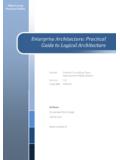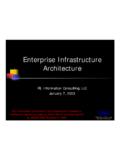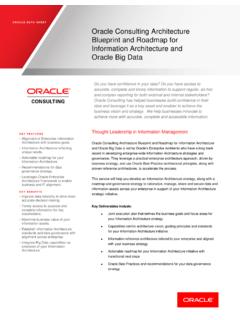Transcription of Modelling the Enterprise Data Architecture - Andrew J
1 Modelling the Enterprise data Architecture Copyright Andrew K. Johnston and Richard Wiggins, 2003 Unlike the simplistic models in books and training courses, a real Enterprise has a very complicated data Architecture . Most of the data will be held in large legacy or package systems, for which the details of data structure may be unknown. Other data will be held in spreadsheets and personal databases (such as Microsoft Access), and may be invisible to the IT department or senior business data administrators. Some key data may reside in external systems maintained by service providers or business partners. As you explore your own complex data Architecture , you come to accept two realities: 1.
2 You have little control over the way high-level business data concepts are realised. data is likely to be highly dispersed, often without adequate controls on quality. 2. Most data is duplicated across a number of systems, with significant variations in quality, format, and meaning. Some of the copies, maintained by Enterprise Application Integration technology (EAI) or careful business processes, may be good (but probably not perfect). Most are very poor, maintained only by occasional batch transfers and stressed or broken manual processes. Organisational and business process conflicts, or simple failures of trust, may get in the way of common sense improvements.
3 The poor copies may be causing business problems. Furthermore, initiatives such as Customer Relationship Management (CRM) and Business Intelligence will need to merge data from various sources. Some organizations work to harness various legacy systems in end-to-end processes. Either the business or IT may be driving changes to simplify business processes, streamline data flows, and reduce duplication. Modelling can be of great benefit in meeting these challenges. But most traditional Modelling approaches don t address these requirements. They produce models which are either too detailed to be of use, or not detailed enough, and typically fail to focus on the difficult issues of the Enterprise data Architecture and the integration of its various components.
4 We believe it is important to create powerful, simple, but effective models of the data structure from an Enterprise viewpoint -- a set of models known as the Enterprise data Architecture . This article describes a new approach, based on UML, which we believe meets the real requirements of Modelling the Enterprise data Architecture . Note: some of the later steps of this approach introduce techniques which may at first seem a little complicated. Don t worry! You don t need to use all the techniques every time, and the earlier stages deliver benefit in their own right. The important thing is to develop models which help to answer your problems. What is the data Architecture ?
5 An Enterprise s information systems Architecture has many interrelated aspects, including applications, hardware, networks, business processes, technology choices, and data . As shown in Figure 1, the data Architecture is a layered set of models which provides a solid foundation for strategic initiatives such as: A data Strategy, outlining the business s aims and objectives for improved collection and use of data , Modelling the Enterprise data Architecture Andrew K. Johnston and Richard Wiggins 2003 Page 1 Business process improvements, Decisions on the future of new and changed systems, Integration, data warehousing, and reporting initiatives. Enterprise data Architecture Models Enterp rise Application Integration Business Intelligence System Rationalisation Business Process Improvement Programmes data Strategy Figure 1: Enterprise data Architecture models support a variety of common IT and business improvement initiatives.
6 Before describing what a data Architecture is, it is helpful to consider first what it is not. As shown in Figure 2, the data Architecture is not the set of detailed models of individual systems, because they cannot convey the big picture information required to meet the above needs. And it is not just the top-level models of business processes and system scopes, since they don t include enough detail to answer the real questions. Figure 2 is a data Architecture map , which shows the scope and context of the data Architecture . The idea is to map the major data areas in the Enterprise on one axis, and the various types of models on the other axis, ranging from highly business-focused models to very detailed system structures.
7 The scope of a complete data Architecture is shown as a band across the middle of the chart: Modelling the Enterprise data Architecture Andrew K. Johnston and Richard Wiggins 2003 Page 2 Business process maps Detailed system physical data models High level data requirements Com mon high level data models Source, consum er and custodian analyses Public standard data models Canonical to system-specific transformations data ware house physical model Produc t data Work data Production data Financial data Personnel data Customer and Trading data Real-time operational data Documents and drawings Scope of data Architecture Conceptual Perspective Specification Perspective Implementation Perspective Realisation overvi ews Figure 2.
8 The data Architecture map shows which models exist for which major data areas in the Enterprise . A complete data Architecture is a band across the middle. The models which comprise the data Architecture are described in more detail in the following sections. The groupings on the horizontal access will vary from Enterprise to Enterprise , but those above represent a typical set. The bands on the right-hand edge are not really part of the map, but show how the models map onto the standard three-level perspective of UML-based methods such as RUP. As well as explaining the scope of data Architecture work, you can use this model to build a map of the current state of knowledge, and the scope of ongoing or planned activities.
9 Simply plot existing or planned Modelling efforts at the appropriate intersection. You can also use colour to indicate the status or validity of a model, which may be useful. The data Architecture map describes what comprises the data Architecture . The data Strategy and initiatives supporting it explain why . The individual models describe what the data is, where it is held, how, when and by whom it is changed. Which Models Constitute the data Architecture ? The data Architecture is defined primarily by models at four levels, described in the following sections. As a general rule the high level data model will only change when there is a significant change in business processes, but the other models will exist in various versions representing the as is structure and one or more to be evolutions.
10 High-Level data Models The top level is a group of high-level data models describing the business data from a conceptual viewpoint, independent of any current realisation by actual systems. Each high-level data model (HLDM) comprises: A common (canonical) UML class model of the main data items (the business entities) and their relationships, Modelling the Enterprise data Architecture Andrew K. Johnston and Richard Wiggins 2003 Page 3 A superset of business attributes, including descriptions of their meaning (semantics), standardised formatting (syntax), and universal constraints. Since these are data models, they will typically exclude class methods, although it may be appropriate to summarise where one business object has responsibility to manage the structure of others.





